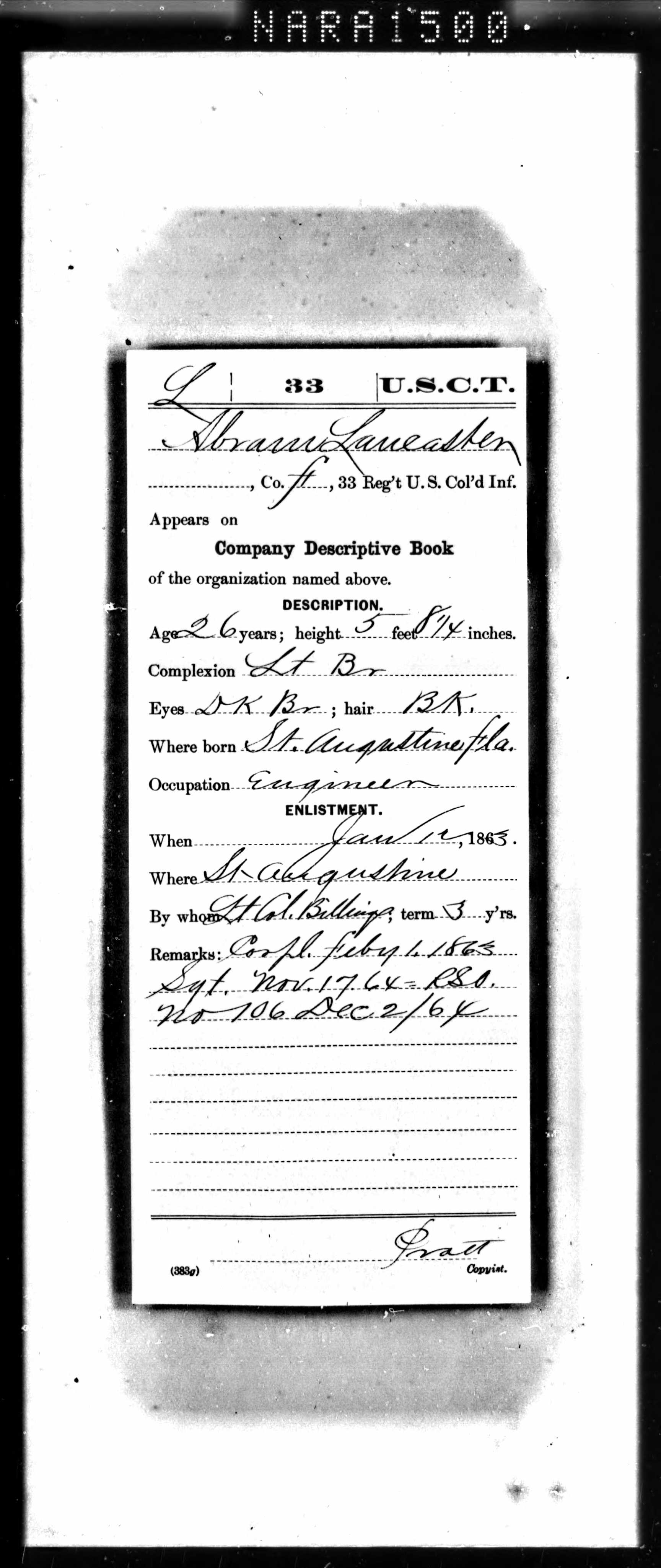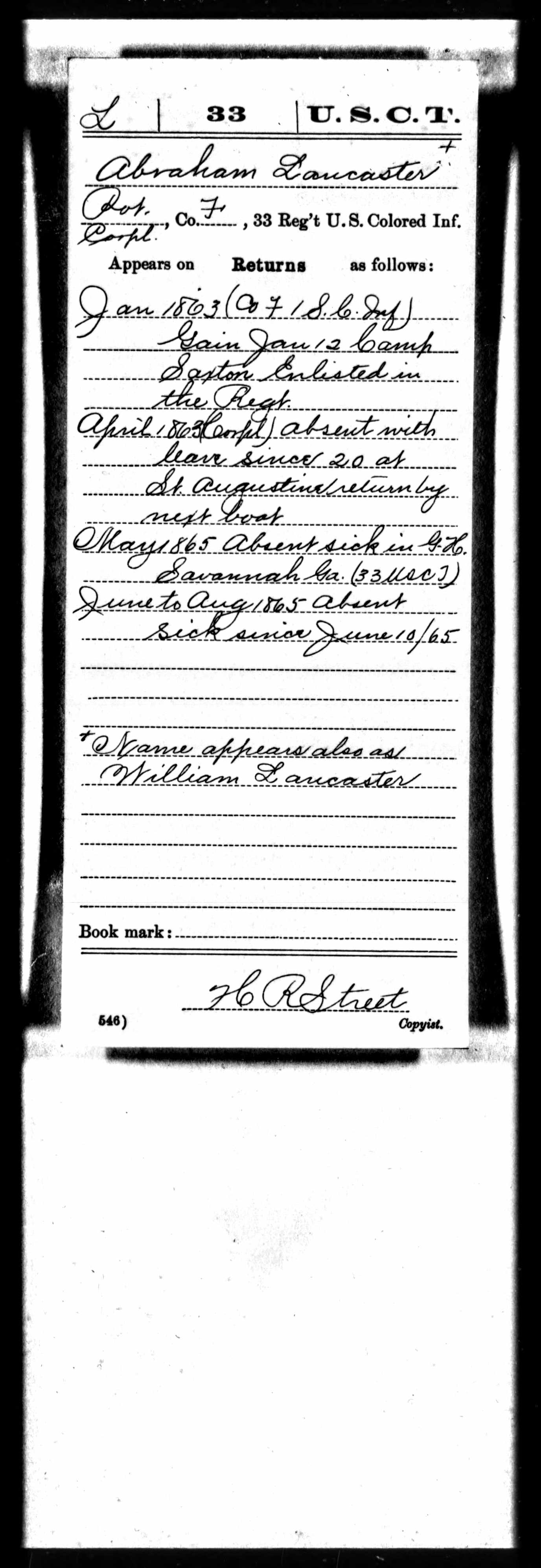Abram Lancaster (c. 1836–July 20, 1904)
By Sara Nazarian
During the Civil War, Abram Lancaster, also known as William Lancaster, served during the American Civil War in the Army as a Private, Corporal, and Sergeant in the Thirty-third United States Colored Infantry (USCI). Born in Saint Augustine, Florida, Lancaster worked as an engineer before entering military service.1
The Civil War began as the seceded states of the Confederacy bombarded Fort Sumter, a Union fort in South Carolina in 1861. Initially, the US government rejected the service of African Americans because the purpose of the war sought to maintain the Union with slavery. However, on September 22, 1862, President Abraham Lincoln issued the preliminary Emancipation Proclamation. Going into effect on January 1, 1863, the act prompted the US Army to recruit black soldiers. In Beaufort, South Carolina, former slaves gathered to hear the reading of the final proclamation on January 12, 1863 at Camp Saxton. On the same day, Lancaster enlisted into the Company F, First Regiment South Carolina Volunteer Infantry in Saint Augustine, Florida at the age of twenty-six, as seen here. The regiment officially mustered on January 31, 1863 in Beaufort as Lancaster served with the unit for three years. Lancaster and his regiment went on to capture Jacksonville, Florida on March 10, 1863.2
On February 1, 1863, Lancaster received a promotion to Corporal. He would take an absence with leave during the months of March and April. During this time, Lancaster started to experience pay cuts. From the time of his enlistment to February 28, 1863, he received thirteen dollars a month in pay, the equivalent of what the Army paid white privates. From February 28 to October 31, his pay was reduced to ten dollars. From October 31 to February 29, 1864, his pay was cut again to seven dollars. His pay was returned to thirteen dollars on June 15, 1864 after Congress passed a bill equalizing pay for black soldiers. Lancaster was promoted again to Sergeant on November 17, 1864. He was demoted back to Private on January 18, 1865. There is no indication as to why Lancaster was demoted.3
On February 8, 1864, the Army redesignated the First South Carolina Volunteer Infantry as the Thirty-third United States Colored Infantry. The regiment went on to participate in the successful capture of the Confederate fortress Battery Gregg on James Island, South Carolina near Charleston. The regiment also took part in the Battle of Honey Hill in South Carolina, a costly defeat for Union forces. During its last year of service, the regiment served with the Union garrison of Savannah and Charleston. On June 10, 1865, Lancaster contracted an illness, as seen here. He later transferred to a hospital in Savannah, Georgia, on June 14, likely the Marshall House Hospital. He recovered and left the hospital on August 2. Lancaster was mustered out in Charleston on January 31, 1866. He owed $9.03 to the United States government, likely for missing equipment.4
After the war, Lancaster returned to Saint Augustine and married his wife Hester. He worked as a stevedore and a carpenter. He started receiving an Army pension on October 1, 1888. 5 Lancaster died on July 20, 1904 and was later interred at the Saint Augustine National Cemetery in Section A, Grave Number 193. His name also appears on the African American Civil War Memorial in Washington D.C. on plaque B-49.6
Endnotes
1 “U.S., Colored Troops Military Service Records, 1863-1865,” database, Ancestry.com (https://ancestry.com : accessed July 3, 2019), entry for Abram Lancaster.
2 “U.S., Colored Troops Military Service Records,” Ancestry.com, Abram Lancaster; Matthew Pinsker, “Emancipation Among Black Troops in South Carolina,” Emancipation Digital Classroom, accessed July 3, 2019, http://housedivided.dickinson.edu/sites/emancipation/2012/11/06/emancipation-among-black-troops-in-south-carolina/; Guide to the 1st South Carolina/ 33 Rd U.S. Colored Troops Records, ca. 1847-1923, 1983, Wyles Mss 30, United States. Army. Colored Infantry Regiment, 33rd (1864-1866), University of California, Santa Barbara Library, Department of Special Collections, https://oac.cdlib.org.
3 “U.S., Colored Troops Military Service Records, 1863-1865,” Ancestry.com, Abram Lancaster; “Sergeant Francis Fletcher of the 54th Massachusetts on equal pay for black soldiers, 1864,” The Gilder Lehrman Institute of American History, accessed July 22, 2019, https://www.gilderlehrman.org/content/sergeant-francis-fletcher-54th-massachusetts-equal-pay-black-soldiers-1864.
4 “Guide to the 1st South Carolina,” University of California Special Collections; “U.S., Colored Troops Military Service Records,” Ancestry.com, Abram Lancaster; “History,” The Marshall House, accessed September 11, 2019, https://www.marshallhouse.com/history.htm.
5 “1880 United States Federal Census,” database, Ancestry.com (https://ancestry.com : accessed July 3, 2019), entry for Abram Lancaster; “1900 United States Federal Census,” database, Ancestry.com (https://ancestry.com : accessed July 3, 2019), entry for Abram Lancaster.
6 “U.S. National Cemetery Interment Control Forms, 1928-1962,” database, Ancestry.com (https://ancestry.com : accessed July 3, 2019), entry for Abram Lancaster; “U.S. Civil War Soldiers, 1861-1865,” database, Ancestry.com (https://ancestry.com : accessed July 3, 2019), entry for Abraham Lancaster; “Lancaster, Abraham,” National Park Service, accessed September 11, 2019, https://www.nps.gov/civilwar/search-soldiers-detail.htm?soldierId=2EE872B1-DC7A-DF11-BF36-B8AC6F5D926A.
© 2019, University of Central Florida




